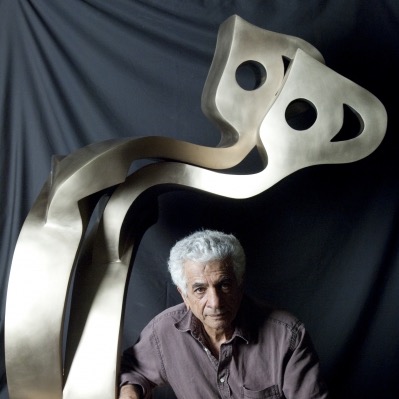Much Ado About ‘Heech’: Parviz Tanavoli Retrospective at the Davis Museum
175 works by Parviz Tanavoli – long since hailed as the “father of modern Iranian sculpture” – is currently on display at the Davis Museum at Wellesley College. This is the first retrospective of Tanavoli’s work held by a museum in the U.S., and the first exhibition of his work in the U.S. since 1976. Spanning the last 50 years of Tanavoli’s career, the retrospective centers on his ‘Heech’ sculptures (the Persian word for ‘nothingness’ and a concept in Sufi philosophy) for which he is most widely recognized, but will also represent works on other mediums such as paint, printmaking, jewelry, and ceramics.
So. Why ‘Heech’? In 2012, Tanavoli was interviewed by the Huffington Post wherein he is asked by the interviewer why he focuses on ‘Heech’ in his artwork. His answer was singularly profound:
Not only was it the attraction of this word — the word and meaning of Heech is so beautiful — but it was also the elegance of the figure of Heech. The slope and elasticity of Heech — the way it can smoothly turn around and associate with chairs and tables and walls and cases and any surrounding objects or space is something I like. And besides that, of course, Heech has a rich story and a long history in our poetry and in our Sufism. It is not simple nothingness. It is a nothingness that voices the wholeness of being. This figure — Heech — makes you think about all of this: of being and not being. Heech, to me, is one word that alone tells the whole story of humanity.
What he says strikes me because the written word is pretty much just visual symbols of the language we use to communicate, yet we never stop to think of words and their physical forms. We don’t consider how perhaps there is more than is being visually communicated to us than just spoken language. Letters, words, written language – they have a physical form that can serve as yet another platform to communicate meaning. A visual structure that reflects the very concepts it conveys linguistically.
Tell me that’s not cool.
To say I admire Tanavoli’s work is an understatement. There are a lot of people who may find the repetition motifs of ‘Heech’ spanning fifty years of one artist’s work to be off-putting or ordinary, but to me it is a testament to those inherent compulsions to completely gut and examine the concepts we find deeply rooted in our cultures. It’s beautiful, and compelling, and so very important.
The retrospective is co-curated by Lisa Fischman; Ruth Gordon Shapiro ’37 Director; and Dr. Shiva Balaghi, Brown University and runs until 7 June, 2015. If you are in the area, most definitely check this exhibition out.

